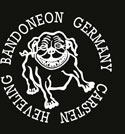

| Carsten Heveling |
| Bando-Aspekte Bandoneon aspects aspectos aspects aspetti |
... zurück back volver retour indietro |
| Charles Péguri Biografie |
Charles Péguri biography |
||||||||||||||||||||||||||||||||||||||||||||||||||
| Charles Péguri (1879 Marseille - 1930 Paris / Frankreich) Akkordeonist, Techniker und Erfinder des gleichtönigen Bandoneonsystems "Système Péguri". Charles Péguri, Sohn italienischer Einwanderer, arbeitete schon in jungen Jahren in der Akkordeonwerkstatt seines Vaters Félix Péguri. In eigenen Werkstätten arbeitete Péguri an der technischen Weiterentwicklung des Akkordeons. Bereits 1897 meldete der 17-jährige Charles mit Hilfe seines Vaters ein Patent für das "chromatische" Akkordeonmodell "Concert Parfait" an. In Paris eröffnete er 1908 seine erste eigene Werkstatt in der Rue de Lappe (11e arr). Es folgte ein Atelier in der Rue de Crimée (19e arr). 1911 eröffnete er sein Atelier in Buttes-Chaumont (Paris, 19e arr). Als Spieler und Techniker sah Péguri das Akkordeon als vollwertiges Musikinstrument und den sogenannten Konservatoriumsinstrumenten gleichgestellt. Péguri arbeitete auch daran, dem Akkordeon eher ein klassisches Aussehen zu verleihen, weg von Verzierungen und dem bunten Erscheinungsbild. Seine erste Werkstatt lag über dem berühmten Tanzlokal "Bal Bousca". Als Akkordeonspieler gilt Charles Péguri mit seinen Brüdern Michel und Louis sowie dem berühmten Akkordeonisten Émile Vacher zu den Schöpfern des "Bal Musette" dort, im "Bal Bousca" in der Rue de Lappe (11e arr) in Paris. Peguri wollte in Tangoorchestern Bandoneon spielen. Als Akkordeonist empfand er das wechseltönige, argentinische System, bei dem bei Zug und Druck die Knöpfe ihre Töne ändern, als ungewohnt. Im Jahre 1925 veränderte Charles Péguri nach der Anregung seines Bruders Louis in einem ersten Schritt das System der rechten Hand zu einem gleichtönigen System auf der Basis des italienischen Akkordeon-Systems. Péguri wechselte dabei nur die wechseltönigen Stimmplatten in fertigen Bandoneons von Alfred Arnold. Die Mechaniken und alle weiteren Teile des Bandoneons konnten unverändert bleiben. So ist ein 142 / wechseltöniges Bandoneon mit 71 Knöpfen von einem gleichtönigen mit 71 Knöpfen von außen nicht zu unterscheiden. Die ersten drei gleichtönigen Bandoneons wurden von Louis Péguri und den Akkordeonisten René Pesenti und Léon Fehlmann gespielt. In dieser Formation wurden sie 1925 vom Pugliese Brodmanns Orchester für Auftritte im Berliner Tanzpalast engagiert. Louis gründete auch sein eigenes Tango-Orchester mit diesen drei ersten gleichtönigen Bandoneons. Nach Gesprächen mit der Fabrik Alfred Arnold baut diese erste Exemplare des gemischten Systems (rechts Péguri, links klassisch wechseltönig). In einem zweiten Schritt entwickelt Charles Péguri ein gleichtöniges System für die linke Hand ebenfalls ohne die Anordnung der Knöpfe zu verändern. So beschränkt sich der Aufwand beim Bau des Instrumentes lediglich auf die Verwendung anderer Stimmplatten. Peguri spielte ein Akkordeon mit dem belgischen System, welches die chromatische Anordnung der Knöpfe in der linken Hand gegenseitig zu der Anordnung in der rechten Hand hat. Dieses gegenparallele System wird auch das "Schweizer System" genannt ... mehr Die Pariser Akkordeonisten fanden das System jedoch ungewohnt und so entwarf Péguri eine zur rechten Hand parallele Anordnung. Diese wurde der vorläufige Standard Frankreich. Die Idee, das klassisch wechseltönige Bandoneon mit einer dem Akkordeon ähnlichen, gleichtönigen Tastatur zu spielen, führte bis heute zu einer Reihe von verschiedenen Entwicklungen. So gab es das sogenannte "Kusserow System" und das "Piano Bandoneon" mit schwarzen und weißen Tasten. Schon 1939 propagierte Alfred Arnold ein ganz neues System mit einer geraden Tastatur und einem Tonumfang, der mit einem A beginnt, im Katalog als "die Zukunft". Zum Schrecken der Welt war ab 1939 die Zukunft eine andere und so blieben diese Entwicklungen praktisch ungespielt. Mit der behutsamen Ergänzung von einzelnen Tönen hat der Französische Bandoneonist Olivier Manoury in den 1980er-Jahren das Péguri-System wiederum perfektioniert. Es wird heute meist von Musikern in Frankreich und Italien gespielt, was mit der Tradition des Akkordeons in diesen Ländern zusammenhängen mag. Heute ist das Bandoneon im wiederentdeckten Tango, der Musik von Astor Piazzolla und weit darüber hinaus ein Instrument, daß sich seine alten Grenzen immer weiter steckt. Mit neuen Spieltechniken und in immer wieder überraschender Musik ist es so vielfältig wie nie zuvor. Bekannte Spieler des "Système Péguri" (kleine Auswahl)
Auf Charles Péguri geht auch die Bezeichnung "chromatasches Bandoneon" zurück. In Frankreich werden die wechseltönigen Akkordeons als "diatonisch" und die gleichtönigen als "chromatisch" bezeichnet. In seiner Methode für das Bandoneonspiel von 1925 spricht Péguri vom "chromatischen" Bandoneon im Gegensatz zum argentinischen, "diatonischen" System. Auch wenn bei Zug und Druck die Töne wechseln, ist das wechseltönige Bandoneon chromatisch in halbtonschritten spielbar. So ist die Bezeichnung "chromatisch" für das von Péguri selbst entwickelte System nicht passend. Heute wird die Bezeichnung "chromatisch" noch oft für das gleichtönige System genutzt ... mehr Leider ist nicht belegt, ob Charles Péguri seine Bandoneons von Alfred Arnold mit Stimmplatten im neuen System geliefert bekam oder ob Péguri die originalen Stimmplatten ausbaute um sie für neue zu ersetzen. Ich vermute letzteres. In diesem Falle könnte unter einem Werkstatttisch in Paris noch eine Kiste mit ungenutzten, wechseltönigen original AA-Stimmplatten liegen. Diese Vorstellung raubt mir den Schlaf. Ich konnte das Bandoneon von Desirée Munier erwerben. Munier war bekannter Bandoneonspieler der Pariser Musikgeschichte ... mehr. Dank seines erhaltenen privaten Telefonbuchs, kennen wir die Namen der vielen Bandoneonisten seiner Zeit: Stephan Alexander Augusto Baldi Fernando Daumesnil Gaston Debeauquesne Jean Dinardo Marcel Feijoo (siehe Foto unten) Aldo Feranguti Louis Ferrari Tito Fuggi Gilbert Govaert Grangereau Hillau Aldo del Maestro Desirée Munier (siehe Foto unten) ... Instr Paone Postolhec Albert Stoop René Tuveri
|
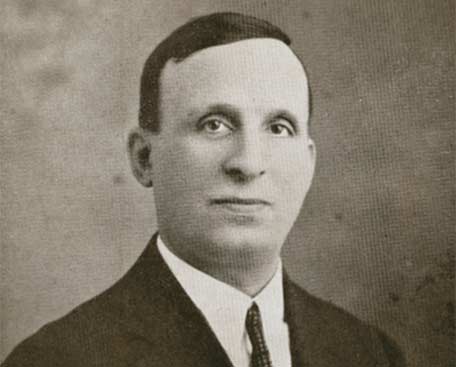 Charles Péguri (1879 Marseille - 1930 Paris) Foto: Collection BB Charles Péguri (1879 Marseille - 1930 Paris) Foto: Collection BBAccordionist, technician and inventor of the single action Bandoneon "Système Péguri". Charles Péguri, son of italian imigrants, worked in the accordion workshop of his father Félix Péguri from a young age. In his own workshops, Péguri worked on the technical development of the accordion. As early as 1897, the 17-year-old Charles, with the help of his father, applied for a patent for the "chromatic" accordion model "Concert Parfait". In 1908 he opened his first own workshop in the Rue de Lappe (11e arr) in Paris. This was followed by a studio in the Rue de Crimée (19e arr). In 1911, he opened his studio in Buttes-Chaumont (Paris, 19e arr). As a player and technician, Péguri saw the accordion as a full-fledged musical instrument and considered it equal to the so called conservatory instruments. Péguri also worked to give the accordion more of a classical look, away from ornamentation and a colorful appearance. His first workshop was located above the famous dance hall "Bal Bousca". As an accordion player, Charles Péguri, along with his brothers Michel and Louis and the famous accordionist Émile Vacher, are considered among the creators of the "Bal Musette" there at the "Bal Bousca" on Rue de Lappe (11e arr) in Paris. Peguri wanted to play the Bandoneon in tango orchestras. As an accordionist, he found the Argentinian diatonic tone system, in which the buttons change their tones when pulled and pressed, unfamiliar. In 1925, at the suggestion of his brother Louis, Charles Péguri changed the right-hand system to an single action system based on the Italian accordion system. Péguri only changed the diatonic reed plates in finished Bandoneons made by Alfred Arnold. The mechanics and all other parts of the Bandoneon could remain unchanged. Thus a 142 / diatonic Bandoneon with 71 buttons is indistinguishable from an single action Bandoneon with 71 buttons from the outside. The first three single action Bandoneons were played by Louis Péguri and the accordionists René Pesenti and Léon Fehlmann. In this formation, they were engaged by Pugliese Brodmann's orchestra for performances at the Berlin Tanzpalast in 1925. Louis also founded his own tango orchestra with these three first single action Bandoneons. After talks with the Alfred Arnold factory, AA builds the first examples of the mixed system (Péguri on the right, classic diatonic system on the left). In a second step, Charles Péguri developed an single action system for the left hand without changing the arrangement of the buttons. The only effort required to build the instrument was therefore limited to the use of different reedplates. Peguri played an accordion with the Belgian system, in which the chromatic arrangement of the buttons in the left hand is the opposite of the arrangement in the right hand. This counter-parallel system is also known as the "Swiss system" ... more The Parisian accordionists, however, found the system unfamiliar and so Péguri designed an arrangement parallel to the right hand. This became the French standard for the time being. The idea of playing the classical diatonic Bandoneon with a keyboard similar to that of the accordion has led to a number of different developments to date. For example, there was the so-called "Kusserow system" and the "Piano Bandoneon" with black and white keys. As early as 1939, Alfred Arnold propagated a completely new system with a straight keyboard and a range beginning with an A in the catalog as "the future". To the horror of the world, the future was a different one after 1939 and so these developments remained practically unplayed. In the 1980s, the French bandoneonist Olivier Manoury perfected the Péguri system by carefully adding individual notes. Today it is mostly played by musicians in France and Italy, which may have something to do with the tradition of the accordion in these countries. Today, in the rediscovered Tango, the music of Astor Piazzolla and far beyond, the Bandoneon is an instrument that continues to push its old boundaries. With new playing techniques and constantly surprising music, it is more versatile than ever before. Well-known players of the "Système Péguri"
The term "Chromatic Bandoneon" also goes back to Charles Péguri. In France, the alternating-tone accordions are referred to as "diatonic" and the equal-tone accordions as "chromatic". In his 1925 method for playing the Bandoneon, Péguri speaks of the "chromatic" Bandoneon in contrast to the Argentinian "diatonic" system. Even if the tones change when pulling and pushing, the diatonic bandoneon can be played chromatically in semitone steps. The term "chromatic" is therefore not appropriate for the system developed by Péguri himself. Today, the term "chromatic" is still often used for the single action system ... more Unfortunately, it is not documented whether Charles Péguri received his Bandoneons from Alfred Arnold with reedplates in the new system or whether Péguri removed the original reedplates to replace them with new ones. I suspect the latter. In this case, there could still be a box of unused, alternating original AA reedplates under a workshop table in Paris. This idea makes me lose sleep. I was able to acquire the Bandoneon from Desirée Munier. Munier was a well-known Bandoneon player in the history of Parisian music ... more. Thanks to his surviving private telephone directory, we know the names of the many bandoneonists of his time (see left)
|
||||||||||||||||||||||||||||||||||||||||||||||||||
|
|
||||||||||||||||||||||||||||||||||||||||||||||||||
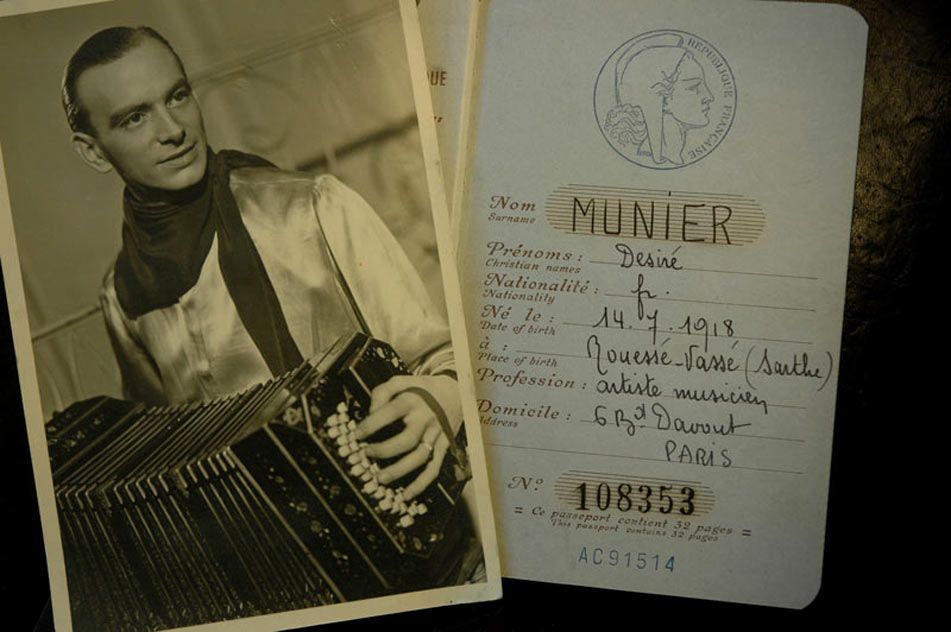 Desirée Munier |
|||||||||||||||||||||||||||||||||||||||||||||||||||
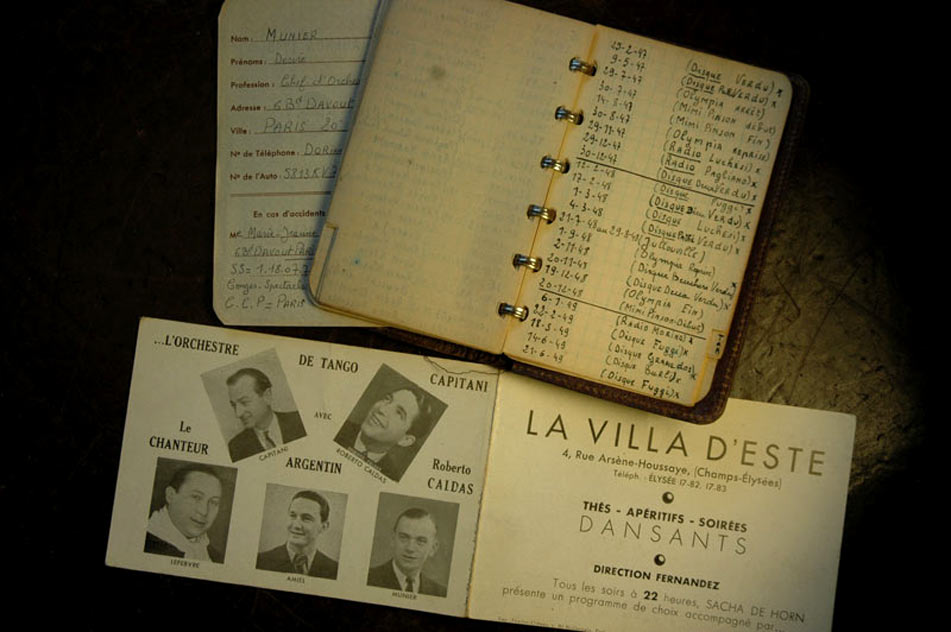 Das private Telefonbuch von Desirée Munier mit Namen von vielen Musikern der Pariser Musik- und Tanz-Geschichte Desirée Munier's private telephone directory with the names of many musicians from the history of Parisian music and dance |
|||||||||||||||||||||||||||||||||||||||||||||||||||
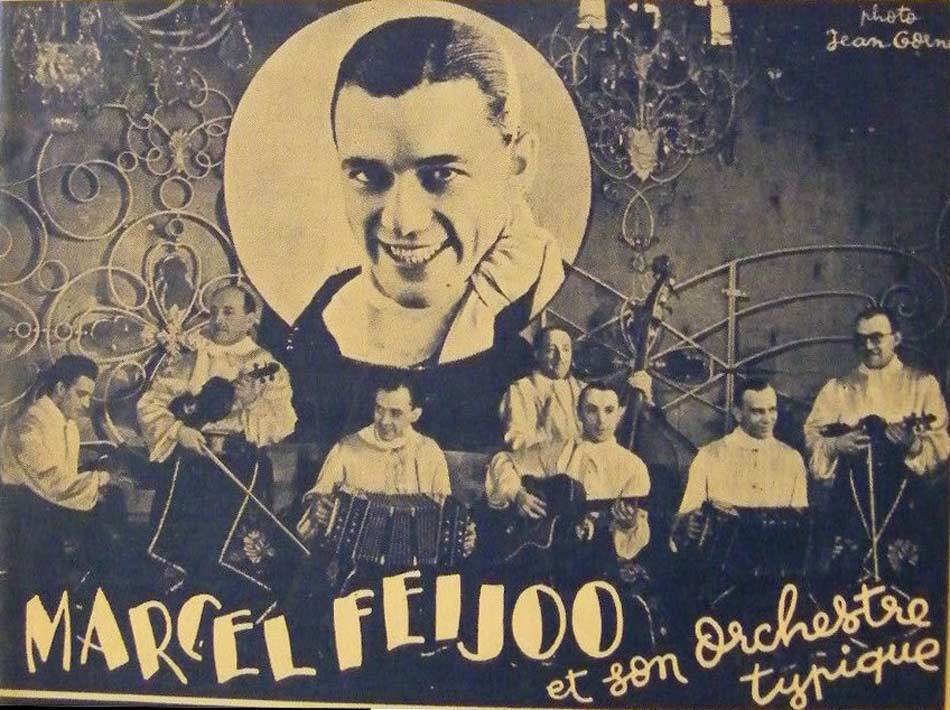 Marcel Feijoo et son orchestre typique - Photo with thanks to William Sabatier ... mehr |
|||||||||||||||||||||||||||||||||||||||||||||||||||
| © 1998-adhuc BANDO BANDO Wuppertal | |
| Kontakt / Impressum Datenschutzhinweis & Hinweise zur Nutzung |